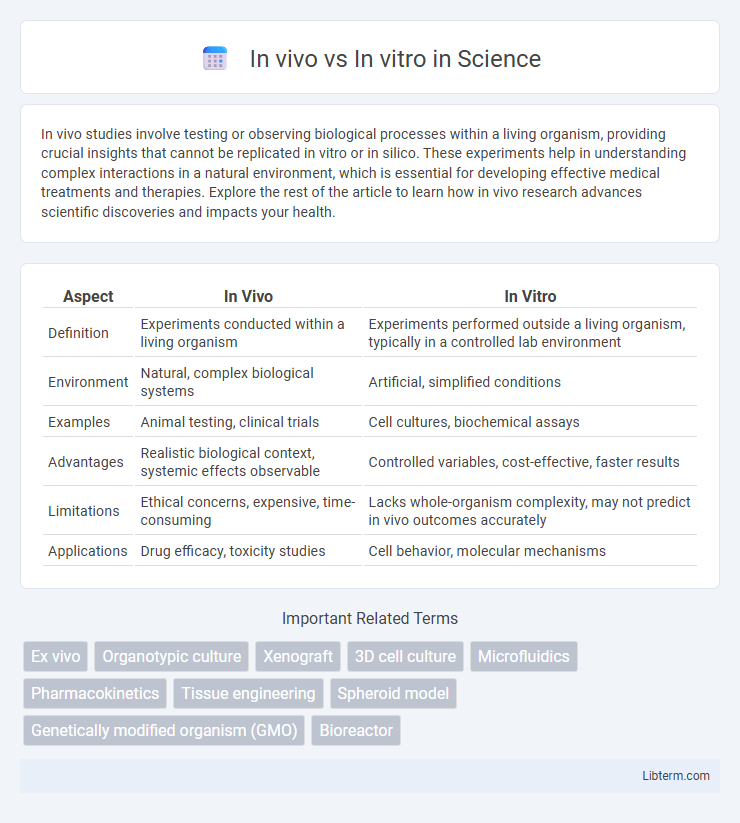In vivo studies involve testing or observing biological processes within a living organism, providing crucial insights that cannot be replicated in vitro or in silico. These experiments help in understanding complex interactions in a natural environment, which is essential for developing effective medical treatments and therapies. Explore the rest of the article to learn how in vivo research advances scientific discoveries and impacts your health.
Table of Comparison
| Aspect | In Vivo | In Vitro |
|---|---|---|
| Definition | Experiments conducted within a living organism | Experiments performed outside a living organism, typically in a controlled lab environment |
| Environment | Natural, complex biological systems | Artificial, simplified conditions |
| Examples | Animal testing, clinical trials | Cell cultures, biochemical assays |
| Advantages | Realistic biological context, systemic effects observable | Controlled variables, cost-effective, faster results |
| Limitations | Ethical concerns, expensive, time-consuming | Lacks whole-organism complexity, may not predict in vivo outcomes accurately |
| Applications | Drug efficacy, toxicity studies | Cell behavior, molecular mechanisms |
Introduction to In Vivo and In Vitro
In vivo refers to experiments conducted within living organisms, allowing researchers to observe complex biological interactions and physiological responses in their natural context. In contrast, in vitro studies are performed outside of living organisms, typically in controlled laboratory environments such as petri dishes or test tubes, enabling precise manipulation of variables and isolation of specific cellular or molecular processes. Both methods are essential in biomedical research, with in vivo models providing insights into systemic effects and in vitro systems offering detailed mechanistic understanding.
Defining In Vivo Studies
In vivo studies involve conducting experiments within a living organism, such as animal models or human subjects, to observe biological processes in their natural context. These studies provide critical insights into the complex interactions and systemic effects that cannot be replicated in isolated cells or tissues. In vivo research is essential for understanding pharmacokinetics, drug metabolism, and the overall physiological impact of treatments.
Understanding In Vitro Experiments
In vitro experiments involve studying biological processes outside a living organism, typically in controlled laboratory settings using cell cultures or tissues. These studies enable precise manipulation of variables and detailed observation at the molecular or cellular level. In vitro models are crucial for drug development and toxicity testing, providing reproducible data while minimizing ethical concerns associated with in vivo research.
Key Differences Between In Vivo and In Vitro
In vivo studies are performed within living organisms, allowing researchers to observe complex biological interactions and systemic effects, whereas in vitro experiments occur outside living organisms, typically in controlled laboratory environments such as petri dishes or test tubes. In vivo methods provide insights into whole-body responses and metabolism, while in vitro techniques enable precise control over experimental variables and are often used for initial screenings or molecular studies. The choice between in vivo and in vitro approaches depends on the research objectives, with in vivo offering physiological relevance and in vitro providing experimental simplicity and reproducibility.
Advantages of In Vivo Approaches
In vivo approaches provide a comprehensive understanding of biological processes within the complexity of a whole living organism, allowing for the observation of systemic interactions and physiological responses. These methods enable assessment of pharmacokinetics, toxicity, and therapeutic efficacy in real-time, which cannot be fully replicated in vitro. In vivo studies bridge the gap between cellular-level data and clinical outcomes, enhancing translational research accuracy.
Benefits of In Vitro Methods
In vitro methods offer precise control over experimental variables, allowing for reproducible and consistent results that reduce the variability seen in in vivo studies. These techniques minimize ethical concerns by eliminating the need for live animal subjects, facilitating high-throughput screening and rapid testing of drug candidates, toxins, or genetic modifications. In vitro systems also enable detailed cellular and molecular analysis in a controlled environment, enhancing the understanding of specific biological mechanisms without systemic interference.
Limitations and Challenges
In vivo studies face limitations such as ethical concerns, high costs, and variability due to complex biological systems in living organisms. In vitro models often struggle to replicate the full physiological context, resulting in challenges like limited cell interactions and simplified environments that may not predict in vivo outcomes accurately. Both approaches require careful interpretation of results to address translational gaps between controlled laboratory settings and whole-organism biology.
Applications in Biomedical Research
In vivo studies enable researchers to observe the complex interactions within living organisms, making them essential for evaluating drug efficacy, toxicity, and disease progression in realistic biological environments. In vitro techniques offer precise control over experimental variables, facilitating cellular and molecular analysis, high-throughput screening, and mechanistic studies under defined conditions. Combining both approaches accelerates biomedical research by providing complementary data that enhance understanding of physiological processes and therapeutic responses.
Choosing the Right Model: Factors to Consider
Choosing the right model between in vivo and in vitro studies depends on factors such as the biological complexity required, the specific research question, and ethical considerations. In vivo models provide a whole-organism context essential for studying systemic effects and pharmacokinetics, while in vitro models offer controlled environments for cellular and molecular analysis with higher throughput. Researchers must also consider cost, time, and the reproducibility of results when selecting the appropriate experimental system.
Future Trends in In Vivo and In Vitro Research
Emerging advancements in in vivo research prioritize personalized medicine through the integration of real-time biosensors and AI-driven imaging technologies that enhance precision in monitoring biological processes within living organisms. Concurrently, in vitro research is rapidly evolving with organ-on-a-chip platforms and 3D bioprinting, enabling more accurate simulation of human tissue environments for drug testing and disease modeling. The convergence of these technologies is expected to accelerate translational research, reducing dependency on animal models while improving the predictive power for clinical outcomes.
In vivo Infographic

 libterm.com
libterm.com